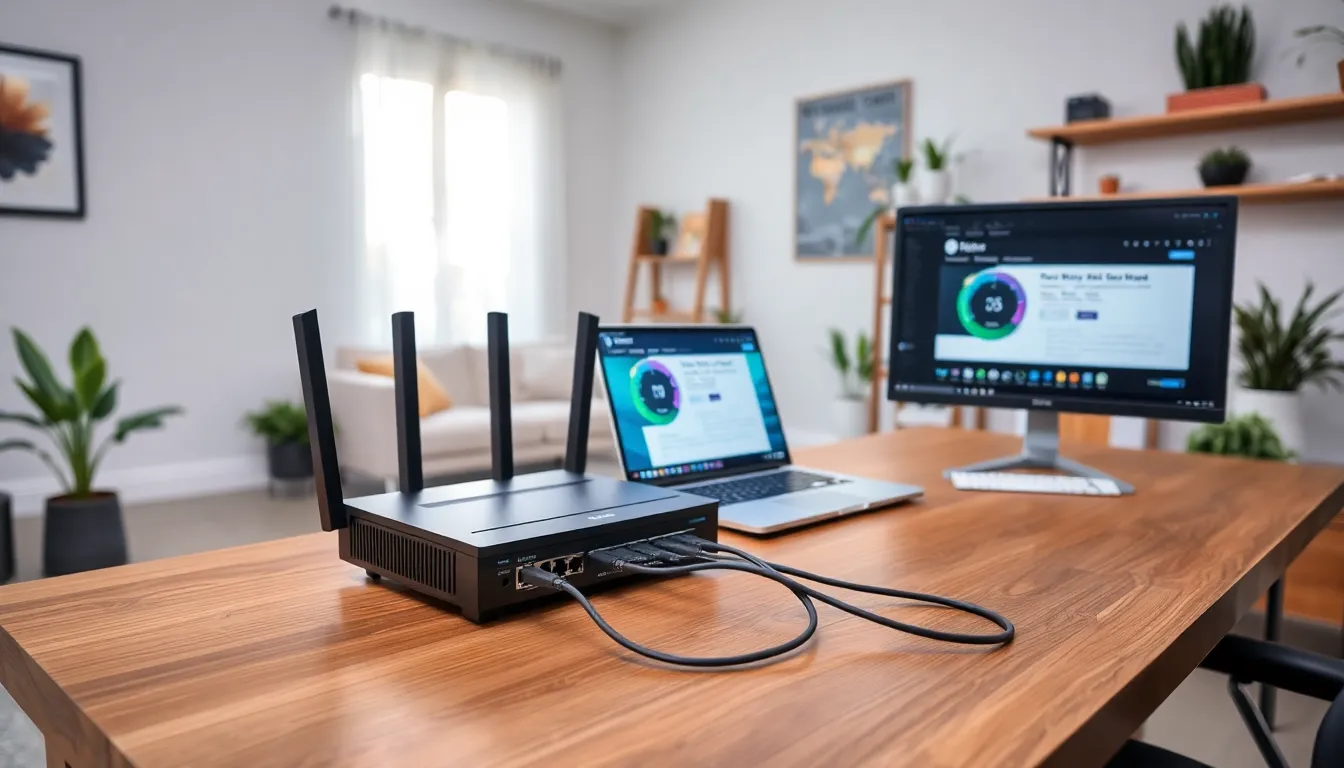Table of Contents
ToggleLet’s face it: setting up your home network can feel a lot like tackling an IKEA furniture assembly, confusing instructions and a longing for a cup of coffee come to mind. But fear not. By the end of this article, you won’t just have a network that works, you’ll have the confidence to rival any IT pro. From understanding the basics to troubleshooting pesky issues, we’re about to demystify the world of home networking. So grab a snack, sit back, and let’s jump into the techy goodness.
Understanding Home Networking Basics

Home networking may sound like a daunting term, but it’s actually quite simple. At its core, it’s about connecting devices within a household to share resources and access the internet. Think of it as a digital neighborhood where your devices can easily communicate.
A fundamental concept in networking is the distinction between wired and wireless connections. Wired connections typically use Ethernet cables for speed and reliability, while wireless networks rely on Wi-Fi for convenience. The choice often depends on individual needs, streaming a movie? A wired connection might be best. Working from home? Wi-Fi could do the trick.
Also, understanding terms like bandwidth, latency, and IP addresses becomes important. Bandwidth indicates how much data can be transmitted, while latency refers to the delay in data transfer. And as for IP addresses, think of them as your device’s postal addresses on the internet. The unique identifier helps devices communicate with one another and the wider web.
Types of Home Networks
When it comes to home networks, variety is the name of the game. Here are the most common types:
- Wired Networks: As mentioned earlier, wired setups are achieved using Ethernet cables. They offer higher speeds and reliability, perfect for gaming or streaming on multiple devices.
- Wireless Networks (Wi-Fi): The most prevalent choice for homes today. Wi-Fi networks use radio waves to connect devices. They offer convenience and flexibility, enabling laptops, tablets, and smartphones to move freely around the house.
- Hybrid Networks: These combine wired and wireless connections to maximize efficiency and speed. For example, a gaming console might be hardwired for speed, while other devices connect via Wi-Fi.
- Mesh Networks: An innovative solution to poor connectivity in larger homes. Mesh networks use multiple nodes or satellites to blanket an area with Wi-Fi, eliminating dead zones and ensuring a strong signal throughout.
Essential Equipment for Home Networking
A successful home networking setup requires specific equipment, and knowing what to buy is crucial. Here’s a rundown of the essentials:
- Router: This is the heart of your network, connecting to your internet service provider (ISP) and distributing the connection to other devices. Look for dual-band routers to support both 2.4GHz and 5GHz bands for flexibility.
- Modem: Often provided by your ISP, the modem connects your home network to the internet. If you already have a router, ensure the modem is compatible with it.
- Ethernet Cables: These are your best friends for wired connections. Invest in quality cables for optimum speed.
- Network Switch: If more devices need to connect via Ethernet than your router ports allow, a network switch can help expand connectivity.
- Wi-Fi Range Extender: This device boosts your Wi-Fi signal in larger homes, so you can binge-watch without interruption, even in the farthest corners.
Step-By-Step Guide to Setting Up Your Home Network
Getting your home network up and running can be straightforward. Here’s a step-by-step guide:
- Choose Your Equipment: Start by selecting a suitable modem and router based on your internet speed and the number of devices.
- Position Your Router: Place it centrally in your home for even coverage. Avoid placing it near microwaves or thick walls that can interfere with signals.
- Connect Your Modem: Plug your modem into a power source and connect it to your router with an Ethernet cable.
- Power On and Configure: Turn on your router and access its settings via a web browser using the address provided in the manual. Set a strong but memorable Wi-Fi password.
- Connect Devices: Finally, connect your devices to the network. For wired connections, plug them into the router with Ethernet cables. For wireless, select the network name and enter the password.
- Test Your Connection: Run speed tests to confirm you’re getting the internet speeds you pay for.
Securing Your Home Network
While setting up your network is essential, securing it is equally crucial. An unsecured network can lead to unauthorized access and slowdowns, or worse, data breaches. Here are some tips to enhance your network security:
- Change Default Passwords: The default passwords on routers are often known to hackers. Change these immediately.
- Enable WPA3 Encryption: Wi-Fi Protected Access 3 (WPA3) is the latest encryption method that significantly enhances security. If available, enable it in your router settings.
- Regular Firmware Updates: Manufacturers regularly release updates to patch vulnerabilities. Ensure your router firmware is updated to the latest version.
- Create a Guest Network: If you have visitors, set up a guest network. This will limit their access to your main devices.
- Use a VPN: Consider a Virtual Private Network (VPN) for additional anonymity and security.
Troubleshooting Common Networking Issues
It’s not uncommon for anyone to face hiccups in their network, but knowing how to troubleshoot can save a lot of frustration. Here are a few common issues and how to fix them:
- Slow Internet Speeds: If your connection is sluggish, it may be a simple matter of too many devices consuming bandwidth. Disconnect unused devices or prioritize bandwidth for essential activities in router settings.
- Wi-Fi Dropouts: This might occur due to interference from walls, microwaves, or even neighbors’ networks. Check the router position or consider a Wi-Fi extender.
- Device Connection Issues: If a device won’t connect, try restarting the router and the device. Often, this simple step refreshes the connection.
- Update Drivers: Ensure your device’s network drivers are up to date. Outdated drivers can lead to connectivity issues.
Future Trends in Home Networking
As technology evolves, so do networking solutions. Here are some trends shaping the future of home networking:
- Wi-Fi 6E: This advanced version of Wi-Fi technology promises faster speeds and less congestion, particularly in crowded environments.
- Smart Home Integration: As smart devices proliferate, seamless integration into home networks will become more vital. Expect devices to automatically configure for optimal performance.
- Artificial Intelligence: AI will play a significant role in managing networks, optimizing performance, detecting anomalies, and improving security.
- Increased Adoption of Mesh Networking: As the demand for seamless coverage grows, mesh networks will become commonplace in households, easily accommodating numerous connected devices.







